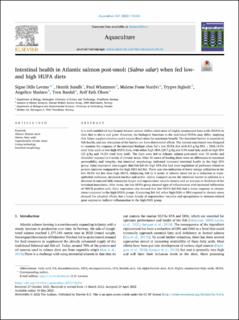| dc.contributor.author | Løvmo, Signe Dille | |
| dc.contributor.author | Sundh, Henrik | |
| dc.contributor.author | Whatmore, Paul | |
| dc.contributor.author | Nordvi, Malene Fosse | |
| dc.contributor.author | Sigholt, Trygve | |
| dc.contributor.author | Madaro, Angelico | |
| dc.contributor.author | Bardal, Tora | |
| dc.contributor.author | Olsen, Rolf Erik | |
| dc.date.accessioned | 2022-09-05T11:18:15Z | |
| dc.date.available | 2022-09-05T11:18:15Z | |
| dc.date.created | 2022-08-29T22:14:02Z | |
| dc.date.issued | 2022 | |
| dc.identifier.citation | Aquaculture. 2022, 557 . | en_US |
| dc.identifier.issn | 0044-8486 | |
| dc.identifier.uri | https://hdl.handle.net/11250/3015763 | |
| dc.description.abstract | It is well established that farmed Atlantic salmon (Salmo salar) need n3-highly unsaturated fatty acids (HUFA) in their diet to thrive and grow. However, the biological functions to the individual HUFAs may differ, implying that future supplementation could require fixed ratios for maximum benefit. The intestinal barrier is essential to f ish health, and any disruption of the barrier can have detrimental effects. The current experiment was designed to examine the response of the intestinal hindgut when fed a low HUFA diet with 8.5 g/kg EPA + DHA (4.5% total fatty acid) or two high HUFA diets, with either high DHA (28.7 g/kg and 5.9% total fatty acid) or high EPA (25 g/kg and 14.2% total fatty acid). The diets were fed to Atlantic salmon post-smolt over 10 weeks and thereafter exposed to 3 weeks of chronic stress. After 10 weeks of feeding there were no differences in intestinal permeability and integrity, but intestinal morphology indicated increased intestinal health in the high EPA group. Gene expression also suggest that fish fed the high EPA diet had more regulation of pathways related to protein turnover compared to the high DHA fed fish. There was also indication of lower energy utilization in the low HUFA fed fish than high HUFA. Subjecting fish to 3 weeks of chronic stress led to a reduction in transepithelial resistance, increased ion flux and active L-lysine transport across the intestinal barrier in addition to a decrease in mucosal fold, enterocyte height and supranuclear vacuole density and an increase in thickness of the intestinal muscularis. After stress, the low HUFA group showed signs of inflammation with increased infiltration of MHCII positive cells. Gene expression also showed that low HUFA fed fish had a lower response to chronic stress compared to the high HUFA groups. Comparing fish fed either high DHA or EPA exposed to chronic stress showed few physical effects, but a lower density of supranuclear vacuoles and upregulation in immune-related gene expression indicate inflammation in the high DHA group. | en_US |
| dc.language.iso | eng | en_US |
| dc.rights | Navngivelse-DelPåSammeVilkår 4.0 Internasjonal | * |
| dc.rights.uri | http://creativecommons.org/licenses/by-sa/4.0/deed.no | * |
| dc.title | Intestinal health in Atlantic salmon post-smolt (Salmo salar) when fed low- and high HUFA diets | en_US |
| dc.title.alternative | Intestinal health in Atlantic salmon post-smolt (Salmo salar) when fed low- and high HUFA diets | en_US |
| dc.type | Peer reviewed | en_US |
| dc.type | Journal article | en_US |
| dc.description.version | publishedVersion | en_US |
| dc.source.pagenumber | 13 | en_US |
| dc.source.volume | 557 | en_US |
| dc.source.journal | Aquaculture | en_US |
| dc.identifier.doi | 10.1016/j.aquaculture.2022.738318 | |
| dc.identifier.cristin | 2046953 | |
| dc.source.articlenumber | 738318 | en_US |
| cristin.ispublished | true | |
| cristin.fulltext | original | |
| cristin.qualitycode | 2 | |

